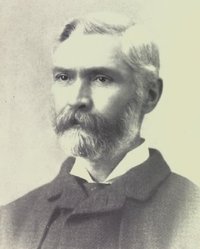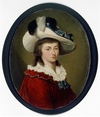
Source: Courtesy of Wikimedia Commons
PEARSE, BENJAMIN WILLIAM, surveyor, politician, office holder, and civil servant; b. 19 Jan. 1832 in Devon, England; m. first 1862 Mary Letitia Pemberton (d. 1872), cousin of Joseph Despard Pemberton*; m. secondly 8 June 1876 Sara Jane (Jennie) Palmer (d. 1954), and they had a daughter; d. 17 June 1902 in Victoria.
According to a contemporary, Benjamin William Pearse’s parents ensured that his “moral and educational training” was “conducted in a most careful manner.” From 1849 to 1851 he worked as a pupil for John George Cockburn Curtis, a civil engineer in London. In early 1851 he was the successful respondent to the advertisement for an assistant placed in the London Times by J. D. Pemberton, the Hudson’s Bay Company’s engineer and surveyor in Vancouver Island. Aged 19, Pearse left London in May and arrived at Fort Victoria (Victoria) in November. On the expiry of his apprenticeship the following year, he became assistant surveyor, a position he would maintain after his transfer in 1855 from the employ of the HBC to that of the colony of Vancouver Island.
Politically a conservative, Pearse became a central member of the colony’s governing élite, the “family-company compact,” and he was involved in its various political, social, military, and economic manifestations. In 1854 he signed a petition calling for the removal of the radical Robert John Staines* from his post as colonial chaplain and schoolmaster. Later he would clash with Governor Arthur Edward Kennedy, who experienced repeated problems with the colony’s assembly. A widely read man with special interests in natural history and theology, Pearse was also involved in the arts. He was a member in 1855 of the first musical ensemble west of the Rockies, and two years later he participated in a theatrical production staged by HBC officers and clerks. In military matters, in 1864 he would help to form the Victoria Rifle Volunteer Corps in response to the threat of Fenian raids from the United States. As assistant surveyor general, he was involved in selling crown land on southern Vancouver Island, a slow task before the Fraser River gold-rush of 1858. Pearse himself bought land, which he began to convert into a small fortune during the rush. Accusations would later surface that he and Pemberton had profited from their control of crown sales.
After Pemberton joined the colonial service in 1859, Pearse served as acting surveyor general during his frequent absences in England, and he resumed the position in 1864, when Pemberton retired. In this capacity he was a member, between 1863 and 1866, of the Executive and Legislative councils of Vancouver Island. As well, he sat on the colony’s General Board of Education, and in 1864 he became chairman of the Lighthouse Board, a position he would hold for seven years. From the union of Vancouver Island and British Columbia in 1866 until the united colony’s entry into Canada in 1871, he was assistant surveyor general under Joseph William Trutch, and seems to have had particular responsibility for the Vancouver Island branch of the Lands and Works Office. Several times between 1866 and 1871 he was again acting surveyor general. In 1870 he joined the Female Immigration Board as deputy chairman under Bishop George Hills*.
In August 1871, a month after British Columbia had joined Canada, Pearse obtained the provincial post of chief commissioner of lands and works and surveyor general. At the same time, Trutch, now lieutenant governor, appointed him to the first Executive Council, which constituted an interim government until Trutch called an election that autumn. Pearse was subsequently replaced as chief commissioner of lands and works by an mla, Henry Holbrook, on 14 November. He remained surveyor general until 7 Oct. 1872, when he resigned to become head of the British Columbia office of the federal Department of Public Works, a job that would give him responsibility for the construction of the first federal buildings and projects west of the Rockies.
In May 1879 New Westminster MP Thomas Robert McInnes and Vancouver MP Arthur Bunster charged Pearse in the House of Commons with jobbery and with building the British Columbia Penitentiary at New Westminster “on a swamp.” Responding in the Victoria Daily Colonist, Pearse called the charges “a gross libel upon my character,” stating that the structure had been built on the driest ground available, with the best materials procurable, and under budget. The Daily Colonist called the accusations “inexcusable”; the Toronto Globe attributed the scandal to Pearse’s refusal to “prostitute his high office by appointing incompetent ‘hacks’ to responsible positions in the department.” Though cleared in an official investigation, Pearse resigned in July 1880. His later recollections of British Columbia’s relations with the dominion would be tinged with some bitterness. Since 1871, he would note in the Daily Colonist in 1900, Ottawa had treated the province “in a most scurvy manner,” taxing it while building elsewhere “wharves, etc. in paltry little places, in exchange for votes.”
Pearse had continued to maintain his social profile. In 1874 he and a number of other Anglicans, including fellow Devonian Henry Pering Pellew Crease, supported one-time HBC chaplain Edward Cridge in his doctrinal dispute with Bishop Hills, as a result of which Pearse and many other former compact members joined Cridge’s schismatic Reformed Episcopal Church. In the musical field Pearse was a founding member of the Victoria Amateur Orchestra in 1879. During his retirement years, in 1885, he would help form the Victoria Musical Society.
Also in the 1880s Pearse strengthened his imperial attachments. In common with most of the colonial élite, he had retained social and institutional links with Britain as though Canada did not exist. In 1889, during a visit to England, he promoted imperial federation, forming a branch of the Imperial Federation League in Great Yarmouth, his second wife’s home town, and lecturing in London, Lewes, and Plymouth. The Daily Colonist followed his efforts, writing that Pearse was “rousing the flagging energies of the Imperial Federationists in Great Britain.” Later, in 1897, he started the Victoria branch of the hawkish, London-based British Empire Navy League, which meant to show that the existence of the empire depended on naval supremacy.
Pearse died of cancer in 1902 at the age of 70, leaving a large estate worth $178,000. His holdings included real estate in Victoria and $73,000 worth of shares, principally in Victoria’s Albion Iron Works and in the Esquimalt Water Works Company. Under the terms of his will, which displayed his imperial and charitable tendencies, he bequeathed money to homes in England for aged and infirm governesses, to Doctor Thomas John Barnardo’s home for boys in London, and to the British Columbia Protestant Orphans’ Home and the Old Men’s Home in Victoria. He left, as well, $10,000 to endow a chair of natural sciences in the event that a college or university was built at Victoria, a project he had promoted since the 1870s. Within weeks of his death, the board of governors of Victoria College was formed to administer this money. Affiliated with McGill University, the college received its first students in 1903.
A slight, bright-eyed man with bushy eyebrows and a black beard, Pearse valued the company of women. In 1900 he reflected that “the ladies were then as now, charming, and many of them beautiful. One can trace the immense influence for good of the ladies, to those who submitted themselves to it; for those, alas! who shunned it, what can now be said?”
Benjamin William Pearse surveyed the Nanaimo area of British Columbia in 1859 and produced two published reports: a seven-page version issued as part of G.B., Emigration Commissioners, Vancouver’s Island; survey of the districts of Nanaimo and Cowichan valley (London, 1859), and a two-page version published under the title General report on the country round Nanaimo ([Victoria?, 1860]). Pearse’s manuscript diary of the survey and his “Official notes country round Nanaimo; field book, 1859” are preserved in the Nanaimo Centennial Museum Arch., Nanaimo, B.C. As deputy chairman of the British Columbia Female Immigration Board Pearse issued a printed sheet entitled “Assisted immigration” (Victoria, 1870); a copy of this document is available at the BCARS.
BCARS, Add. mss 120; Add. mss 1912, box 9; Add. mss 1950, box 142; A/E/C86/C86/P312; C/AA/30.1 M/58, 25 April 1854; C/AA/30.73J/2; C/AB/30.7J/8A, 16 Nov. 1871; C/AB/30.7M; D-19, B. W. Pearse file; E/B/M45; E/B/P31; GR 983, esp. Pearse to Walkem, 17 Oct. 1872; GR 1069, I.156; GR 1169; GR 1304, file 1902/2541; GR 1372, F 15/22; F 542/2; F 867/25; F 914/5; F 955/23; F 956/3; F 9057; K/L/P31. City of Victoria Arch., City clerk’s office, ser.11, 8 Sept. 1877, 29 Aug. 1879. NA, RG 10, 3596, file 1241 (mfm. at BCARS). PAM, HBCA, A.10/30: f.396. PRO, CO 305/ 15 (mfm. at BCARS). Ross Bay Cemetery (Victoria), Tombstone inscription.
Daily Colonist (Victoria), 1864–80; 24 March 1889; 1893–1900; 17–18 June, 12–13 July, 15 Aug. 1902. Globe, 20 Aug. 1879. H. R. Boutilier, “Vancouver’s earliest days,” BCHQ, 10 (1946): 151–70. A. T. Bushby, “The journal of Arthur Thomas Bushby, 1858–1859,” ed. Dorothy Blakey Smith, BCHQ, 21 (1957–58): 83–198. Can., Dept. of Public Works, General report of the minister of public works from 30th June, 1867, to 1st July, 1882 (Ottawa, 1883). Directory, Victoria, 1868. Chad Evans, Frontier theatre: a history of nineteenth-century theatrical entertainment in the Canadian far west and Alaska (Victoria, 1983), 16–17. “Extracts from the Public Works reports, British Columbia, 1865–66,” Directory, B.C., 1877/78: 114–24. Fort Victoria letters, 1846–1851, ed. Hartwell Bowsfield, intro. M. A. Ormsby (Winnipeg, 1979). “Hon. Benjamin William Pearse,” Northwestern Rev. of Seattle (Seattle, Wash.), 1 (1891), no.5: 35 (copy at City of Victoria Arch.). F. W. Howay, “Early settlement on Burrard Inlet,” BCHQ, 1 (1937): 101–14. Journals of colonial legislatures of Vancouver Island and B.C. (Hendrickson), vol.1. R. D. McIntosh, A documentary history of music in Victoria, British Columbia (Victoria, 1981). Rosemary Neering, The story of the University of Victoria and its origin in Victoria College (Victoria, 1988). Scholefield and Howay, British Columbia, 4: 1070–73. Oliver Wells, General report on the Cowichan valley ([Victoria?, 1860]).
© 1994–2024 University of Toronto/Université Laval
Image Gallery

Cite This Article
Richard Mackie, “PEARSE, BENJAMIN WILLIAM,” in Dictionary of Canadian Biography, vol. 13, University of Toronto/Université Laval, 2003–, accessed April 16, 2024, http://www.biographi.ca/en/bio/pearse_benjamin_william_13E.html.
The citation above shows the format for footnotes and endnotes according to the Chicago manual of style (16th edition). Information to be used in other citation formats:
| Permalink: | http://www.biographi.ca/en/bio/pearse_benjamin_william_13E.html |
| Author of Article: | Richard Mackie |
| Title of Article: | PEARSE, BENJAMIN WILLIAM |
| Publication Name: | Dictionary of Canadian Biography, vol. 13 |
| Publisher: | University of Toronto/Université Laval |
| Year of publication: | 1994 |
| Year of revision: | 1994 |
| Access Date: | April 16, 2024 |











